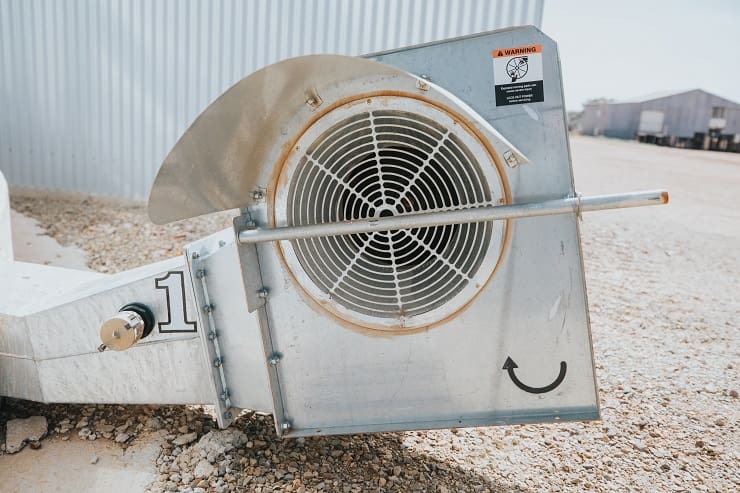WITH harvest well underway in parts of the eastern Australian wheat belt and the realisation of the forecast wetter than average conditions, attention is now focussed on managing the harvest.
Many growers are giving consideration to high moisture harvesting to maximise harvest returns where weather presents an abnormal challenge in otherwise dry harvest environments.
 Farming and grain handling infrastructure in much of the inland cropping areas is geared more towards the typical dry harvest.
Farming and grain handling infrastructure in much of the inland cropping areas is geared more towards the typical dry harvest.
In a year such as this, harvesting equipment can be sitting idle and crops exposed to risk of losses waiting for the grain to dry in field.
By “dry” we typically mean the GTA receival standards – 12.5 per cent moisture content for cereals, 8pc for canola and 14pc for pulses.
These moisture limits reflect the safe storage moisture levels assuming minimal intervention by way of drying or aeration.
In the last few weeks, growers in many areas have been struggling to harvest at these levels.
What to consider
Understanding the options to manage a higher moisture harvest is the key to getting through a harvest such as we are seeing.
There are three considerations when contemplating high moisture harvest;
- Can the harvesting equipment manage the higher moisture crop? In general, this will not be a limitation as the equipment is designed to handle crops at higher moisture than needs to be considered for Australian winter crop harvest.
- Is the grain physiologically mature? Once again, in practice, this will not be a limitation as, in the case of wheat, maturity is reached at around the 30pc moisture content. It is possible that harvesting early will see a higher percentage of green grains. The green grains will desiccate in storage however care needs to be taken to limit the percentage to avoid downgrade.
- Can the higher moisture grain be managed in storage? Typically, grain cannot be delivered above the GTA limits, so it will need to be managed until it is dried within limits.
High moisture storage threats
The risk associated with storing high moisture grain is that the resultant air humidity within the grain promotes mould activity, which in turn leads to seed decay.
Mould activity is increased in warmer conditions and, in turn, it also results heat build-up.
So, the key to managing high moisture grain is to keep it cool (to minimise mould growth) and dry the grain prior to delivery.
Whilst the management of high moisture grain adds to the harvest workload, the alternative is delayed harvest, yield loss and potential downgrade.
Blending and aeration
Managing the higher moisture grain is generally achieved by blending and aeration.
Blending is perhaps the easiest management tool.
Typically grain is harvested at a range of moistures.
Often, soon after a rain event or mornings will generally see higher moisture whereas later harvested grain may be drier.
The ability to blend (assuming the grain is the same quality) can manage the high moisture grain with minimal time and cost.
It is recommended that blended grain by aerated for one or two days to even out the moisture.
Grain can be safely held up to 14pc or 15pc moisture (for cereals) under a cooling aeration system.
Typically this would be a system where the distribution is well designed to ensure that air flow reaches all parts of the store (silo, shed or bunker) and that the air flow is sufficient to cool the grain quickly to safe temperatures.
The air flow recommended for silo storage is typically 3 to 4 litres per second per tonne. This provides an air change approximately every 3 minutes.
Normally the air selected for cooling provides only limited drying.
Anecdotally, cooling aeration can dry grain however it will be slow (weeks and months) and therefore this strategy is aimed primarily at maintained the grain safely until it can be blended or dried.
High air flow
Higher flow aeration systems 15 litres/second/tonne and above, provided they have a uniform air distribution system can be used for drying the grain down.
 Typically this would allow wheat to be harvested at up to 18pc.
Typically this would allow wheat to be harvested at up to 18pc.
Drying with these air flows is still relatively slow (days and weeks).
The time to dry is very much dependant the air flow, the moisture content of the grain and the prevailing ambient weather conditions.
Storage precautions
There are a few precautions that should be considered when storing higher moisture grain:
- The grain should be regularly inspected. Check for moisture condensation, smell for mould activity etc
- Confirm the aeration system being used. In particular the fan should be designed to provide the flow rate at the pressure needed when grain is in storage.
- The distribution system should be engineered to ensure all grain is receiving correct air flow. Dead zones will lead to grain spoilage.
- Ensure that the grain storage is correctly vented to allow the aeration air to exit.
- Controlling the fan operation correctly is essential. An aeration controller which monitors the ambient conditions is the most reliable means of fan control. The controller should have a calibrated weather sensor and provide control for the mode of aeration being undertaken. I.e. a cooling cycle for aeration cooling and a drying cycle for aeration drying.
Andrew Kotzur is managing director of grain silo and storage manufacturing business, Kotzur, based at Walla Walla in southern NSW.

HAVE YOUR SAY